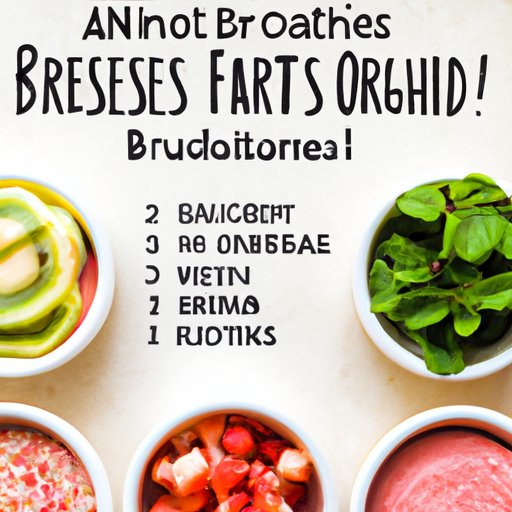
Introduction
If you have braces, you already know that you need to take extra good care of your teeth. Braces are delicate, and improper care can cause harm to the brackets, wires, and other components. But did you know that diet plays a significant role in protecting your braces? Certain foods can damage your orthodontic appliances, leading to discomfort, interrupted treatment, and even extended treatment time. In this article, we’ll go over the foods to avoid with braces, alternatives to difficult-to-eat foods, and best practices for eating while wearing braces.
The Top Foods to Avoid with Braces
There are three categories of foods that you should avoid while wearing braces: hard foods, sticky foods, and sugary foods. These types of food can be difficult to chew, get stuck in your wires and brackets, and promote tooth decay. In the following paragraphs, we’ll break down why you should avoid such foods.
Hard Foods
Hard candies, nuts, popcorn, and ice are some examples of hard foods that you should avoid while wearing braces. These foods can easily crack or break the wires and brackets, leading to discomfort and delays in the treatment. If you must eat hard foods, cut them into small pieces and chew them carefully with your back teeth.
Sticky Foods
Caramel, gum, toffee, and other sticky foods are no-go for those who wear braces. These sugary treats can stick to your braces, and it’s tough to clean them out thoroughly. As a result, they can lead to plaque buildup, tooth decay, and cavities.
Sugary Foods
Cookies, cakes, and other sugary foods are okay in moderation, but it’s important to limit your intake of them. Regular consumption of sugary foods can lead to the accumulation of bacteria in your mouth, which can cause tooth decay, cavities, and gum disease. It is best to have them in small amounts and brush your teeth immediately after eating them.
Alternatives to Problematic Foods
Just because you’re wearing braces, it doesn’t mean you have to miss out on your favorite foods. There are many alternative options that are just as satisfying and less damaging to your braces. For example, if you’re craving something crunchy, you can eat cucumber or carrot sticks instead of chips or crackers. For a sweet treat, consider eating sliced fruits or fruit sorbets instead of sticky candies. Be creative with your food choices and experiment with new, healthier alternatives.
Recipe Ideas for People with Braces
Eating with braces can be intimidating, especially during the first few weeks of treatment. But don’t worry; we’ve got you covered. Check out the following recipe ideas that are soft, easy to chew, and don’t require a lot of biting or tearing.
Breakfast:
- Oatmeal with soft fruits such as banana or blueberries
- Scrambled eggs with soft vegetables such as spinach or mushrooms
Lunch:
- Mashed avocado and hummus dip with soft pita and cooked veggies
- Soft pasta dishes with tomato sauce and protein options like tofu or meatballs
Dinner:
- Soups and stews that are cooked long enough to have tender, stewed meat and cooked vegetables
- Mashed sweet potatoes or baked squash with roasted vegetables
Snacks:
- Sliced fruits that are easy to chew such as bananas, peaches, and kiwis
- Yogurt with soft berries and honey
Myth-busting and Common Misconceptions
There is a slew of myths and false rumors related to braces and dietary restrictions. After all, everyone knows you can’t eat popcorn, right? However, there are some common misconceptions that need to be cleared up.
For instance, some people believe that chewing gum can make their braces come off. However, sugarless gum is safe to chew and can even help remove food particles from braces. Additionally, it’s a common misconception that all candy is off-limits while wearing braces. While it’s true that chewy or sticky candies can cause damage to braces, it’s possible to enjoy alternatives such as chocolate or sugar-free candy, in moderation and with proper care afterwards.
Best Practices for Eating with Braces
Following a braces-friendly diet is the first step to protect your appliance, but there are other things you can do to minimize the risk of damage while eating. The following tips will help you take care of your braces:
- Brush and floss your teeth after every meal
- Cut your food into small pieces and chew slowly with your back teeth
- Avoid biting directly into fruits and vegetables, cut them into small pieces instead
- Don’t eat hard or chewy sticky foods
- Avoid sugary drinks such as soda or fruit juice, instead choose water or milk
Conclusion
Eating with braces can present a challenge, but taking the time to follow a braces-friendly diet can minimize your risk of encountering any problems. Avoiding hard, sticky, and sugary foods, trying out new alternatives, and taking care of your teeth while eating can set you up for success. Don’t hesitate to get creative with your meal plans and always remember that it’s worth it to take care of your orthodontic appliances.




